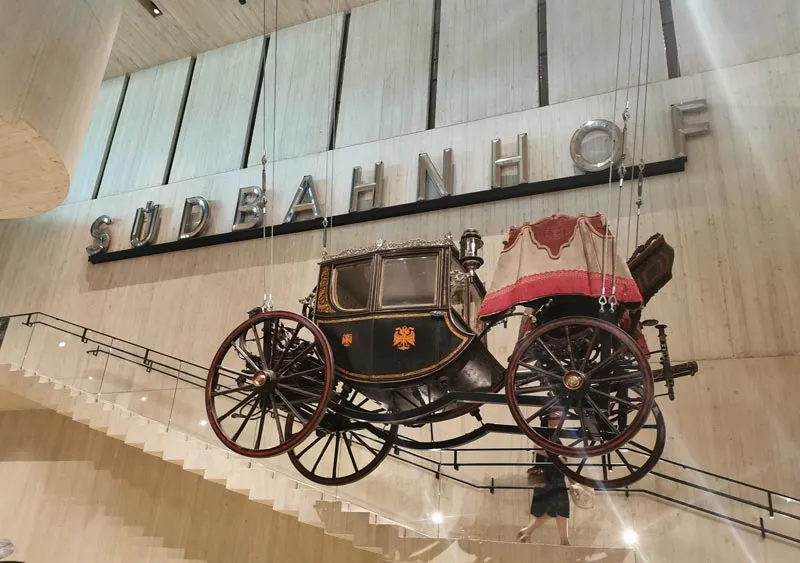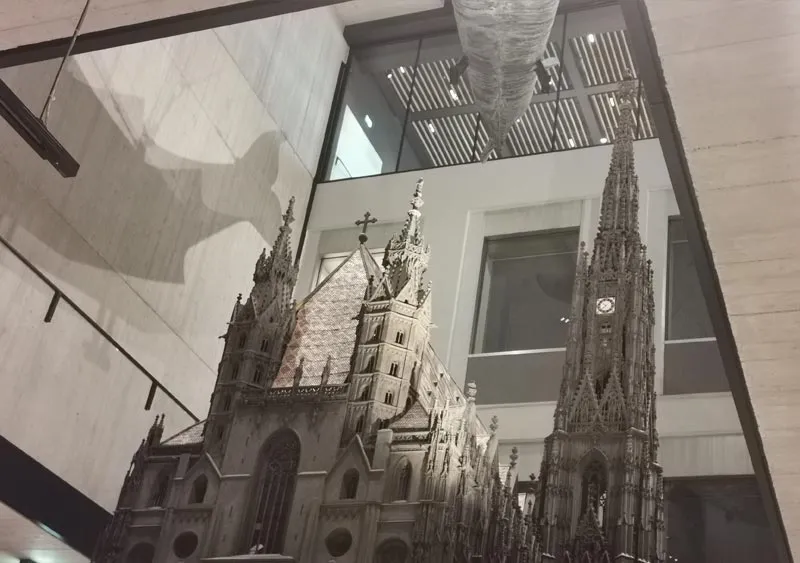The Wien Museum is a must when in Vienna, Austria. The newly renovated and expanded museum offers visitors an insight into the historical impact of the former imperial city, which stood at the center of a great empire. From Metternich’s briefcase, to larger-than-life models of St. Stephan’s Cathedral and paintings of Gustav Klimt, the Wien Museum underscores why Vienna is consistently ranked as the number one livealbe city in the world.
Diana Mautner Markhof
10 July 2024
Chinese version | German version | Spanish version
The Wien Museum, located in the heart of Vienna’s first district on the historic Karlsplatz, recently re-opened after a multi-year renovation/extension project. This remarkable Museum should be on everyone’s to-do list when visiting or living in Vienna. A stroll through the three floors of the Museum presents the visitor with special insights into the city of Vienna’s history, spanning thousands of years – from the Neolithic age to the present day. Entry to the Museum is free of charge. It is Austria’s first museum to adopt this approach.



An inviting glass pavilion at the entrance, a modern café in the courtyard, an event center and educational studios are part of this new, improved and enlarged museum. The newly designed permanent exhibition, “Vienna. My History”, spans three floors and 3300 square meters of exhibition space. The expanded and modernized exhibition area allows many previously hidden treasures to be on display. In addition to extending the original building, an upper floor was added as well as a concrete cube which floats above the original building. All in all, the usable space was doubled, making room for 1700 objects.
The building was originally designed by the architect Oswald Haerdtl, a former employee of the famous architect and designer Josef Hoffmann. Haerdtl’s design won the competition for the original Wien Museum, which was opened on 23 April 1959 as the first new museum building of the Second Republic.
The Museum’s highest profile artifacts are from the 19th and early 20th centuries, including paintings and artifacts by Gustav Klimt, Egon Schiele, Richard Gerstl and Otto Wagner. The beauty of Klimt’s world-famous portrait of his companion Emilie Flöge is breathtaking. The other less well-known pieces leave a lasting impression, such as two handcrafted models of the historic city of Vienna and an enormous model of Vienna’s St. Stephan Cathedral.
Other highlights of the Museum include the original, larger-than-life princely figures of Rudolf IV the Founder, his wife, Katharina of Bohemia, his in-laws and parents, Emperor Karl IV, Blanche of Valois, Albrecht II Duke of Austria and Joanna Countess of Pfirt. These statues had previously stood in St. Stephan’s Cathedral and were a display of the Habsburgs’ power and prestige. They are unique not only because of their workmanship, but also because they were created and used during the lifetimes of these historical personalities.



The former atrium of the Museum was transformed into a spacious 25-meter-high central hall, where the Museum’s mascot “Poldi”, a ten-meter-long,1.7-ton sculpture of a whale from the legendary Prater restaurant Zum Walfisch, hangs from the ceiling together with a stately mayoral carriage used by the first Mayors of Vienna.
Also on display in the atrium space are the original sculptures of the Donnerbrunnen fountain. The Donnerbrunnen is the centerpiece of Vienna’s Neuer Markt square. It was completed in 1739 and named after its creator, the famous Austrian sculptor Georg Raphael Donner. The figures on the fountain are 1873 bronze copies of the originals and feature multiple allegorical statues of the four rivers which flow into the Danube River: the Enns, March, Traun und Ybbs Rivers. They are some of the first examples of secular public art. The central figure of Providentia, Latin for care, refers to the city of Vienna and its care for the public good, including Vienna’s famous water supply.
 Original sculptures of the Donnerbrunnen fountain
Original sculptures of the Donnerbrunnen fountain

 Briefcase of Metternich
Briefcase of Metternich
City planning and design is also what makes Vienna so unique. Emperor Francis Joseph built the first water supply line into Vienna which led, i.a., to the introduction of public toilets, also on display at the Wien Museum. The First High Spring Pipeline is part of Vienna’s water supply system. It was opened in 1873. The 95-kilometre-long pipeline cost 16 million guilders (c. EUR 180 million) and provided Viennese for the very first time with clean drinking water. It became a symbol for the liberation from water shortages and the danger of epidemics. In particular, the diseases of cholera and typhus were greatly reduced by the city-wide supply of hygienically safe spring water. The First High Spring Pipeline is a pure gravity pipeline, which means that the water is only transported by the effects of gravity.
Thanks to the introduction of further water catchments, the total length of the First High Spring Pipeline is now 150 kilometers. It transports 220 million liters a day from the Rax, Schneeberg and Schneealpen regions to Vienna.
The Museum also features Franz Grillparzer’s original salon and Adolf Loos’ innovative living room. Another piece on display is the world’s oldest and most complete horse armor from the Habsburgs. It is the oldest object of its kind still in existence. Originally this armor was not used to protect the horse during battle, but designed to display political power and technological superiority. The armor was imported from Milan, Italy, the then-center for armor production.
A quirky piece on display is Prince Metternich’s briefcase – in bright red. Metternich is famous as the initiator and organizer of the Congress of Vienna which led, i.a., to the balance of power and lack of major wars in post-Napoleonic Europe.
A walk through the Museum is a walk through Vienna’s history, highlighting its importance as a center for technical advances, art, design, music, fashion and jewelry. Vienna was the center of world politics for many centuries, witnessed revolutions, the rise of the industrial age and modern political parties, and survived two World Wars.
The Wien Museum is worth many visits while in town and underscores why Vienna is consistently ranked as the number one liveable city in the world.







